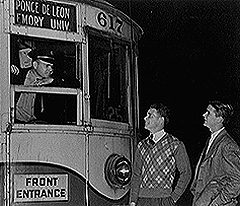Please permit me one small correction. In the third paragraph you refer to "E. Stanley Frazier, a Methodist minister and avowed segregationist." Actually, he was G. STANLEY FRAZER. His full name was George Stanley Frazer. I knew him quite well. You spelled his name like Dr. King did in his book, I think confusing the first initial with that of Dr. E. Stanley Jones, whose viewpoint was vastly different from that of Dr. Frazer, and of course mine was too. Incidentally, both Dr. and Mrs. King also misspelled my last name as Wadley in their books though they both knew me personally.
At the time of the beginning of the bus protest in December 1955, I chaired the local Council on Human Relations in Montgomery, of which Dr. King was also an officer and Mrs. King was a participant. I was a Methodist pastor in Montgomery as was Dr. Frazer. My church was located about midway between that of Dr. King and that of Dr. Frazer and Dr. Frazer was a former pastor of my church.
Dr. Frazer was undoubtedly the most eloquent and forceful voice for segregation among all clergy in the state of Alabama at the time. He was a gentleman of the old South who strongly felt the "fabric of society" in the South would fall apart if the wall of segregation was breached. He also thought that the Methodist Church in the South would disintegrate if the Annual Conferences were racially integrated. Time has proved him wrong on both counts.
Ray E. Whatley '48T
Lake Junaluska, North Carolina

Of particular interest to me is how often the pictures that were made that night have resurfaced. The photographer was from the Atlanta Journal or the Constitution and one of the pictures and a story about the Emory trolley appeared about a week after it was made.
In 1981, The Trolley Titans, a book about the history of public transportation in Atlanta, was published and one of the pictures was used. Then this past March 31, one of the photos accompanied an article in the local newspaper reviewing the traffic problems in the Emory area without identifying the students. I took the opportunity to make a pitch for public transportation [in an article] the following week.
My brother Joe (right) had a Saturday job as a salesman at Butler's Shoe Store, which is still on the corner of Peachtree and Alabama streets near the Five Points MARTA station. I had met him for dinner and a movie that evening, and we were the only persons on the trolley when it arrived at the campus. The photographer took several pictures to record this "last" Emory trolley trip.
The following afternoon, Sunday, I was sitting in Dobbs Hall with friends killing time when I saw one of the new trackless trolleys at the "bus stop" at Asbury Drive and Arkwright Drive, across the street from Winship Hall. I went out to take a ride on the newest mode of transportation and ran into the same photographer. He wanted to take a picture of me boarding the "first" trackless trolley, but I was too embarrassed to let him make the picture. Just another example of missed opportunities in the strangest places. Hope to live long enough to get another look at one of these pictures from the archives.
Stephen F. Dean '49C
Avondale Estates, Georgia
Photo courtesy Special Collections